We are very pleased to republish this important article by Efe Can Gürcan, Associate Professor at Türkiye’s Istinye University, which originally appeared in Volume 3 Issue 3 of the BRIQ (Belt & Road Initiative Quarterly).
The author argues that China has already developed a firm understanding of its environmental problems and their severity to the extent that it now frames them as a “matter of survival” and has brought these issues to the center of its revised national security strategy. China’s strategy is predicated on an alternative proposal for “ecological civilization”, which may potentially lead to the reversal of “ecological imperialism”. China is in the early stages of building an ecological civilization and requires a lot of work to reach a high level of ecological development.
China’s key achievements on the path towards ecological civilization involve a series of three unfolding and mutually conditioning revolutionary processes that also lead the way in international environmental cooperation. They include a clean energy revolution, a sustainable agricultural revolution, and a green urban revolution.
China has already become a global leader in green finance. It leads the eco-city movement, with over 43 percent of the world’s eco-cities being Chinese, and is the second leader in sustainable architecture, next to Canada. Many Chinese cities have dropped down or out of the list of the most polluted cities, leaving India and Pakistan at the top. China’s cities have also joined the ranks of those with the strongest sewage treatment capacity in the world. In addition, China has the most electric vehicles, bikes, and efficient public transportation. China is considered to be not only the world’s centre of electric bus production and consumption but also as having cities with the world’s longest subway systems.
From 2013 onwards, the share of coal in China’s total energy consumption has seen a noticeable decline, accompanied by the increasing share of renewable resources in total energy consumption as a result of conscious efforts at a clean energy revolution.
Key to this revolution in the making is China’s strong reputation as the world’s top investor in clean energy. As such, it has succeeded in creating the world’s largest wind, solar, and hydroelectric systems for power generation.
Finally, concerning China’s unfolding revolution in sustainable agriculture, one should acknowledge, not only its adoption of green food standards and the expansion of its agricultural area under certified organic farming, but especially the fact that, as a world leader in green agriculture, it now ranks third in the list of countries with the largest agricultural area under organic farming.
China is the world’s largest country by population size and fourth largest by surface area. Combined with its excessive demographic and geographic size is the continued legacy of Western imperialism in China as a former semi-colony, whose negative effects are amplified by current Western efforts in geopolitical and geo-economic containment. This adds to China’s resource scarcity which acts as another structural adversity constraining its development potential. China possesses only 7% of the world’s arable land and freshwater resources and 8% of the world’s natural resources, even though its population represents 22% of the world’s population. Furthermore, only 19% of its surface area is suitable for human habitation and 65% of its surface area is rugged, which severely cripples China’s farming capabilities and facilitates ethnic heterogeneity as a potential impediment to political cohesion (Morton, 2006; Naughton, 2018).
Despite such adversities, China has come to develop an exemplary model of economic development that inspires much of the developing world. The 1979-2018 period testified to an average growth rate of 9.4% in the lead of the Communist Party of China (CPC), which made China the world’s second-largest economy, top producer, and the leading exporter of technological goods (Hu, 2020). By 2015, China came to assume the global production of 40% of washing machines, 50% of textiles, 60% of buttons, 70% of shoes, 80% of televisions, and 90% of toys. Recently, China has made significant progress in the production of added higher-value products in computer, aviation, and medical technology sectors, among others. Besides its historic success in economic growth, industrial production and technological development, the Chinese economic miracle is credited for 70% of global poverty eradication between 1990 and 2015 (Gardner, 2018).
The huge ecological cost of such a fast-paced and dramatic development –unprecedented in the history of human civilization– is nothing but expected. According to 2009 estimates, the annual economic cost of environmental pollution amounts to 3.8% of China’s Gross Domestic Product (GDP) (Zhang, 2014:32-48). Over 80% of China’s underground and river water resources are no longer fit for human use due to pollution (Jie, 2016). Land pollution and soil erosion are also part of China’s major environmental problems. It is common knowledge that excessive use of pesticides and industrial pollution constitute a major source of land pollution, prompting the loss of organic matter and soil erosion. 2013 estimates suggest that close to 20% of China’s cultivated farmland suffers from contamination and 38% of the soil is subjected to erosion-related loss of nutrients and organic matter (Scott et al., 2018:26; Gardner, 2018:9). Indeed, the contraction of arable land is a natural result of soil contamination and erosion. This also explains China’s over 4% loss of arable land between 1990 and 2018, from 124,481,000 to 119,488,700 hectares (FAO, 2021; Figure 1).
China being the world’s largest pesticide producer and consumer exacerbates this tendency. In the 1990- 2018 period alone, China’s pesticide use rose by 129% (FAO, 2021; see Figure 2). Furthermore, 70% of the world’s electronic waste is recycled in China at the expense of environmental and public health. Industrial pollution, environmentally detrimental recycling practices, and industrial agriculture combined to create China’s “cancer villages” (Gardner, 2018). Map 1 provides a more detailed outline of China’s major environmental problems (Sanjuan, 2018).
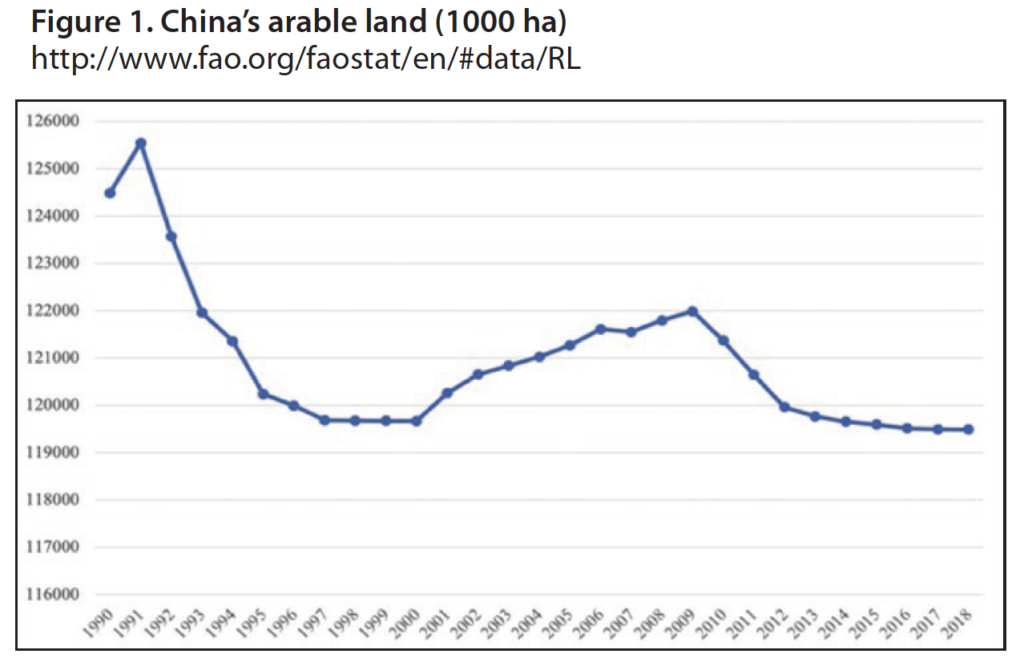
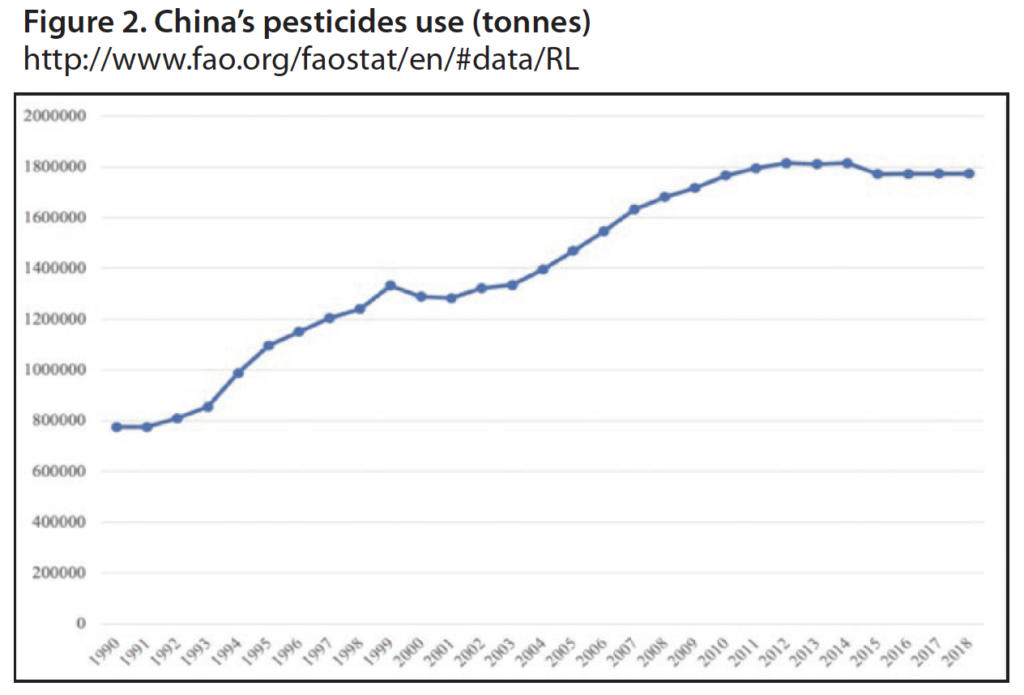
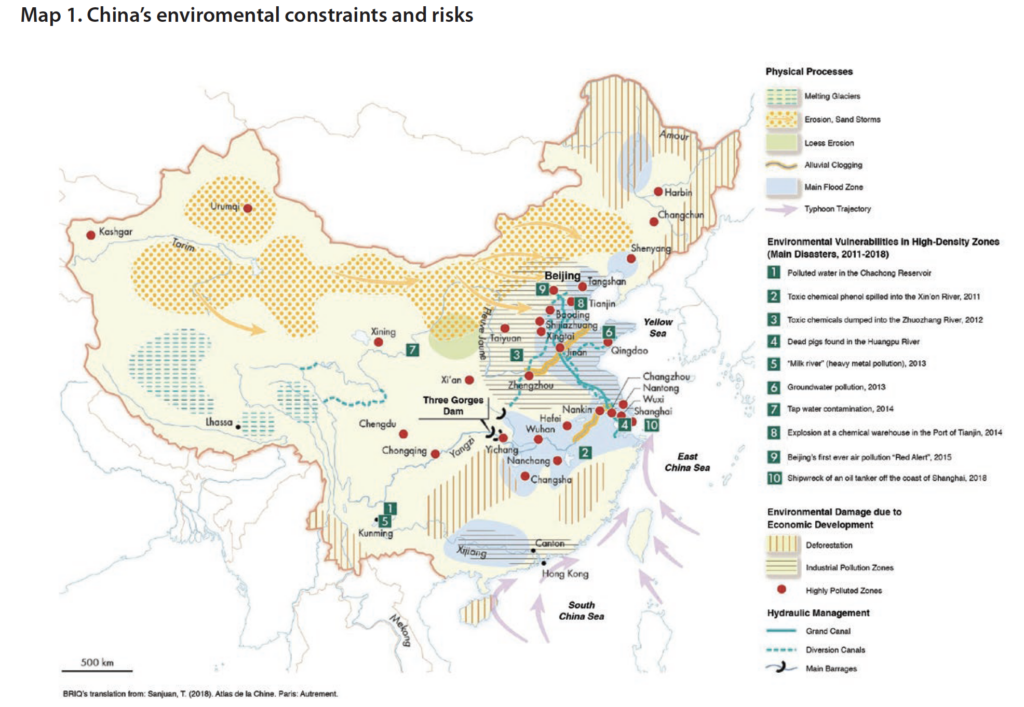
Global environmental indicators provide a general picture of the environmental question’s severity in China. To elaborate, the Environmental Performance Index (EPI) is a popular indicator to assess the impact of national policies on the environment. EPI is made up of two major components: environmental health and ecosystem vitality. Environmental health looks at the negative impact of environmental pollution on human health as well as air and water quality and sanitation. In turn, ecosystem vitality focuses on variables such as carbon intensity, biodiversity, fish stocks, forest cover, wastewater treatment, and nitrogen balance (Environmental Performance Index, 2020a).
China’s EPI can be compared to other BRICS (Brazil, Russia, India, China, South Africa) countries, representative of the leading developing countries, and the United States (US), as the hegemonic leader of the capitalist-imperialist system. A comparison for the period 2010-2020 shows that China has achieved the second-largest increase in EPI scores (8.4 EPI points) after South Africa (8.5 EPI points), which testifies to China’s successful efforts at improving its environmental standing (Table 1). In the same 10-year period, India has recorded no visible improvements, while the increase in EPI scores for Brazil, Russia, and the US are 4.9, 3.9 and 2.9, respectively. In the meantime, one should note that China’s 2020 standing is 120 out of all the 180 countries included in EPI. China’s 2020 score is 37.3, which outranks India with an EPI score of 27.6. However, China is outranked by Brazil, Russia, South Africa, and the US, whose annual scores are 51.2, 50.5, 43.1, and 69.3, respectively (Table 1). Overall, this comparison reveals that China has exhibited a strong environmental will and achieved policy success between 2010 and 2020, even though it continues to struggle with severe environmental problems (Environmental Performance Index, 2020b).

Ecological footprint is another global environmental indicator. It is popularly used to assess the human impact on an environment by reference to changing natural resource demands for countries across the world. With ecological footprint, the use of ecological resources is compared with the size of biologically productive land and sea area to estimate the earth’s capacity to renew the natural resources and absorb waste (Robbins, 2007:509-10). Not surprisingly, the ecological footprint of China –as a rapidly developing country– has known a constant increase, particularly in the 2000s (Figure 3).
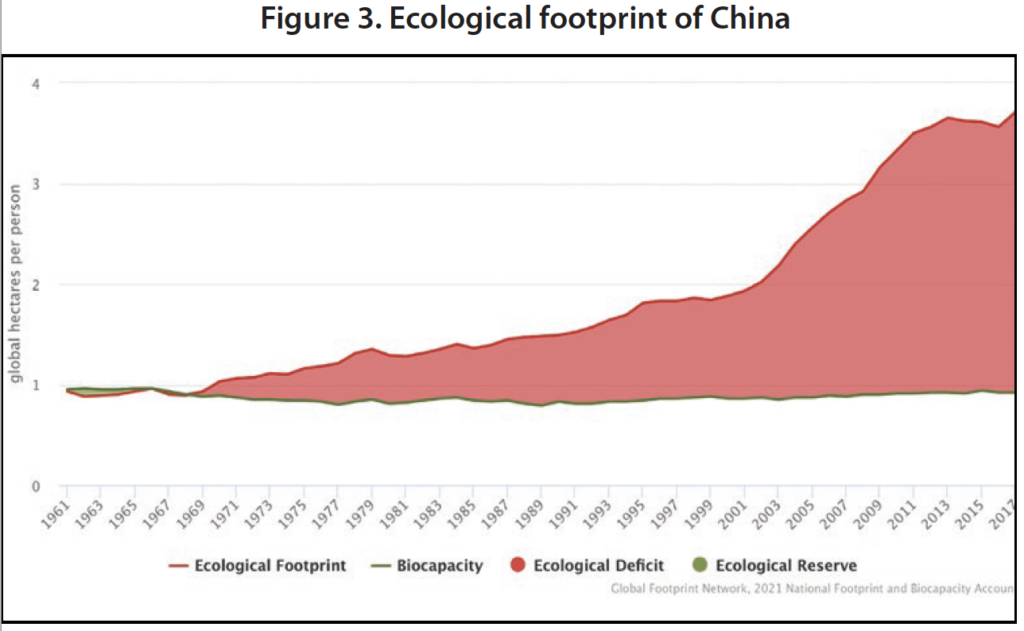
Air pollution stands out, perhaps, as the most visible environmental strain in China, which is why it is worth supplementing our analysis of EPI and ecological footprint with what is popularly known as fine particles, or particulate matter 2.5 (PM2.5). Available data allow us to comparatively assess the performance of the BRICS countries and the US concerning the percentage of the national population exposed to PM2.5 levels exceeding the World Health Organization (WHO) guideline value. One striking fact that emerges from this comparison is the successful performance of the US and Brazil, unlike China and other countries in our sample. The US and Brazil’s PM2.5 performance in the period 2011-2017 declined from 46.69% and 91.93% to 3.34% and 68.14%, respectively (World Bank, 2021, Figure 4). Even though China failed to exhibit a successful performance by 2017, its post-2017 performance offers promising prospects. Recently, for example, Chinese cities used to occupy the forefront of the list of the world’s most polluted cities. Looking at the 2020 list of the fifteen most polluted cities, however, it is now being occupied by Indian and Pakistani cities. The only Chinese city that is ranked among the top fifteen polluted cities is Hotan (Earth.Org, 2021, IQAir, 2021; Zhang, 2014).
China has been undergoing a sustainable urban revolution, which extends beyond the fight against air pollution. It is striking to notice how China’s daily capacity for urban sewage treatment rose from 125 million tons to 182 million tons in the period 2010-2015. This elevates China to be among the world’s strongest capacity for urban sewage treatment (China-ASEAN Environmental Cooperation, 2018). Moreover, China has greatly improved its performance in urban sustainability by prioritising green architecture and transportation. According to the Leadership in Energy and Environmental Design (LEED) rating system prepared by the US Green Building Council, China is the world’s second leader in sustainable architecture after Canada (Long, 2015). China’s strong leadership in sustainable urbanisation can also be observed in its emergence as the world’s largest market for electric vehicles and bikes (Statista 2021; INSG 2014). As far as public transportation is concerned, China is the world’s largest producer and consumer of electric buses (Technavio, 2019; Sustainable Bus, 2020; MarketsandMarkets, 2021). Furthermore, China has turned itself into the world leader in green transportation, with Beijing and Shanghai having developed the world’s longest subway systems (Nedopil Wang, 2019).
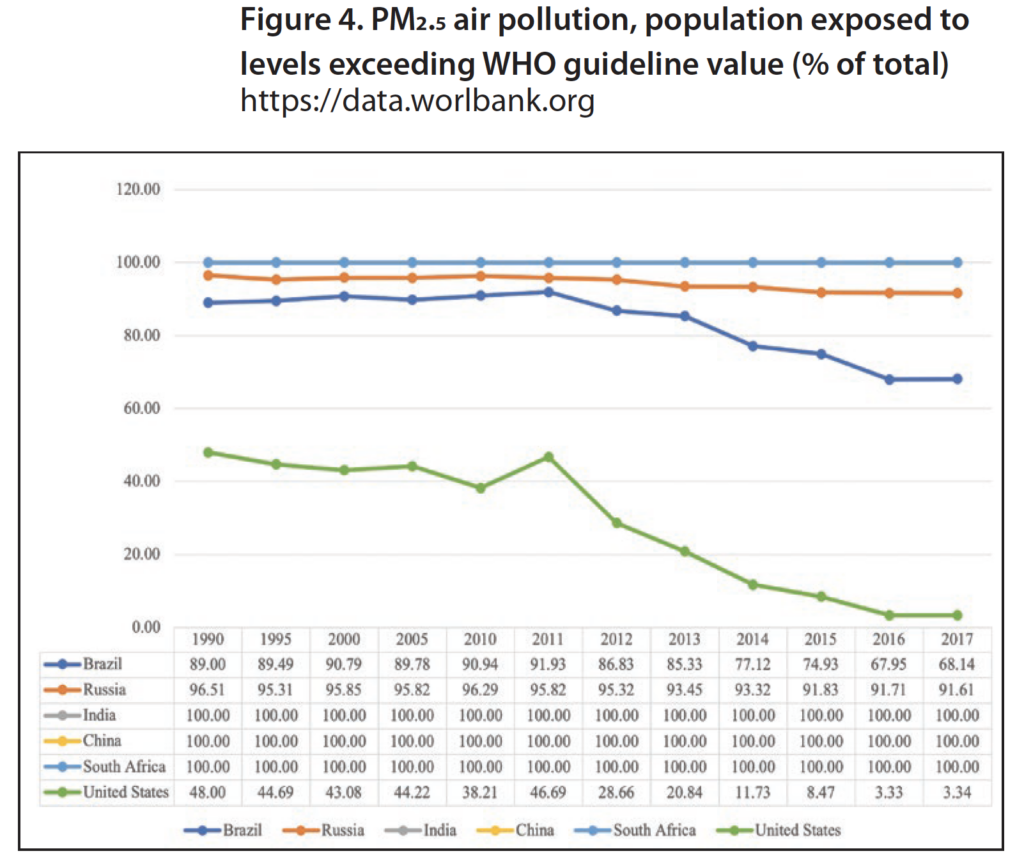
Evidently, China’s world-leading environmental achievements go unnoticed due to the prevailing discourse of “ecological imperialism” in environmental politics. Ecological imperialism describes the shift of axis in global labour and natural resource exploitation to the developing world at the expense of grave human and ecological suffering. The economic and ecological burden of this axis shift is placed on the shoulders of the developing world by Western metropoles, which essentially seek to externalise the cost of production and resource extraction (Gürcan, Kahraman, & Yanmaz, 2021). Indeed, this phenomenon has been a defining feature in the entire history of capitalism. However, the dominance of neoliberalism as a global policy paradigm since the 1970s gave a new impetus to ecological imperialism, where China emerged as the main target. This being said, China has refused to be victimised by such policies and actively took advantage of the changing policy environment without fully abandoning its socialist system, albeit at grave ecological and socioeconomic costs in the medium term. In this period, China relied on the state’s strong guidance on reform and opening-up to build the “Chinese dream” of socialist welfare through gradual technology transfers and joint ventures in the longer term.
It is common knowledge that Western capitalism globalised through exploration and colonisation at the expense of grave human and ecological costs. These globalising efforts were amplified by the Industrial Revolutions, which eventually evolved into imperialist rivalries for spheres of influence and world wars. A subsequent wave of globalisation began in the 1970s as the world’s axis of production shifted to Asia, based on neoliberal policies that sought to take advantage of Asia’s cheap labour supply and other resources in the absence of strict political and environmental regulations. For some time, Western metropoles remained content with China’s accommodating policies, only until it succeeded in using the “privilege of backwardness” to consolidate its national economy rather than become a mere US colony governed by the World Bank and the International Monetary Fund (IMF). Upon China’s historic economic success and the continuation of the rule of the Communist Party of China (CPC), it seems that Western metropoles ended up developing a false sense of threat against their global hegemony, which prompted them to launch a global campaign of imperialist propaganda framing China as an environmentally irresponsible villain versus the West as the virtuous watchdog of environmental values.
This article seeks to transcend Western-centric ecological-imperialist biases toward China’s environmental policies and provide a more balanced perspective. What environmental issues occupy China’s main development agenda? How does China address these crucial issues? In what direction are China’s environmental policies evolving? The present article uses process tracing to answer these questions and argue that China has already developed a firm understanding of its environmental problems and their severity to the extent that it now frames them as a “matter of survival” and has brought these issues to the centre of its revised national security strategy, particularly under the Hu Jintao and Xi Jinping administrations. China’s strategy is predicated on an alternative proposal for “ecological civilization” (shengtai wenming, 生态文明), which may lead to the reversal of “ecological imperialism”. Particularly noticeable in this regard is China’s ongoing clean energy revolution as well as its strong leadership in green agriculture, urbanisation, and multilateral environmental cooperation. Accordingly, the present article is structured into three sections. The first focuses on the political and ideological background of China’s “ecological civilization” project and the second sheds light on China’s clean energy revolution. The article concludes with the third section on China’s achievements in green agriculture and ecological urbanisation, explaining how they are reflected in multilateral environmental cooperation.
The Political and Ideological Background of Ecological Civilization
The first uses of the term “ecological civilization” can be found in the Soviet Union in the early 1980s. This term was later adopted by Qianji Ye, a Chinese agricultural economist, and brought into official use by the State Environmental Protection Administration (SEPA). In China, ecological civilization gained popularity thanks to the efforts of the Hu Jintao administration (2003-2013) (Greene, n.d.; Pan, 2016:35). In his report to the 17th National Congress of the CPC, Hu put forth the notion of “harmonious society” by reference to China’s traditional philosophical conception of harmony between humans and nature (天人合一思想) (Hu, 2007; Kitagawa, 2016a; Pan, 2016).
Hu’s (2007) conceptualisation of “harmonious society” goes beyond social equality and justice to embrace the “balance between urban and rural development, development among regions, economic and social development, relations between man and nature, and domestic development and opening to the outside world”. Worthy of note is the degree to which this notion resonates with Mao Zedong’s ideas of “balanced development” and “socialism with Chinese characteristics”, as were described in his speech “On Ten Great Relationships” (Mao, 1974).
Hu (2007) proposed a “Scientific Outlook on Development”, where harmonious society can be achieved with a sustainable development model that puts people and the environment first by mobilising science, technology, and education. According to Hu, energy conservation and sustainable development are central to improving the Chinese population’s quality of life. In this framework, Hu developed a “five-in-one” strategy (五位一体) that combines the task of economic, political, cultural, and social construction with that of ecological civilization. This strategy emphasises how ecological sustainability and other tasks complement each other. To elaborate, ecological sustainability is an essential requisite for long-term economic growth for, without it, the higher goals of social welfare and life quality cannot be attained (Kitagawa, 2016b; Pan, 2016).
Xi Jinping’s ascendancy to power furthered the strength of Hu’s emphasis on harmonious society and ecological civilization (Xi, 2018:233). In Xi’s thought, the task of building an ecological civilization constitutes the building block of the Chinese dream, i.e. “a dream of building China into a well-off society in an all-round way and… a dream to show the world China’s commitment to making a greater contribution to the peace and development of mankind” (Xi, 2018:179). As such, the CPC adopted the task of building an ecological civilization as a priority task in 2012, added it to the CPC constitution, and imported it into the Chinese constitution in 2018 (Goron, 2018:39).
Xi Jinping’s rise led to the creation of the first CCP organ specialised in sustainability: the “Task Force for the Promotion of Economic Development and Ecological Civilization”. In 2015, the CPC Politburo adopted the “Central Opinion Document on Ecological Civilization Construction” in March 2015. As part of China’s new centralised environmental inspections, over 29,000 companies were penalised with fines totalling 1.43 billion RMB (US$216 million), 1,527 individuals were detained, and 18,199 officials were subjected to disciplinary action (Goron, 2018:41). Ultimately, the 19th National Congress of the CPC held in 2017 set the goal of greening and beautifying China based on the principles of green development and ecological-civilization building (China Daily, 2017; Yang, 2018).
China started to frame the environmental question as a matter of “state survival” in the Xi Jinping era, which explains why this question occupies such a strategic place in China’s revised national security strategy. In his speech during the first meeting of the Central National Security Commission of the CPC in 2013, Xi Jinping announced China’s new “Holistic National Security Outlook”, which constitutes the backbone of China’s current national security and identifies 11 areas of priority in national security. This sustainability included: political security, homeland security, military security, economic security, cultural security, societal security, science and technology security, information security, ecological security, resource security, and nuclear security. Subsequently, China published its “Blue Book on National Security” in 2014, designated as the country’s first blue book on national security. A landmark feature of this book is how it extends the scope of national security to include environmental issues as a defining theme (Corff, 2018; Raik et al., 2018).
“Made in China 2025”, China’s new techno-industrial strategy announced in 2015, is shaped by Xi’s holistic conceptualisation of national security and identifies nine areas of priority for economic development. These include enforcing green manufacturing, improving manufacturing innovation, integration between information technology and industry, strengthening the industrial base, fostering Chinese brands, advancing restructuring of the manufacturing sector, promoting service-oriented manufacturing and manufacturing-related service industries, and internationalising manufacturing. According to the Made in China 2025 strategy, the key to success in these tasks is in strategic sectors such as “new information technology, numerical control tools and robotics, aerospace equipment, ocean engineering equipment and high-tech ships, railway equipment, energy-saving and new energy vehicles, power equipment, new materials, biological medicine and medical devices, and agricultural machinery” (Ma, et al., 2018; U.S. Department of Defense, 2020).
China’s Clean Energy Revolution in the Making
In 2009, China outranked the US as the world’s largest energy consumer (Guo & Marinova 2014). Chinese energy consumption greatly contributes to environmental degradation and climate change. In fact, 2016 estimates suggest that China exhibits a better performance in constraining per capita carbon dioxide (CO2) emissions in comparison with the US, Russia, and South Africa (World Bank, 2021; Figure 5). This being said, China recorded the highest rise in per capita CO2 emissions (around 380%) in our sample for the 1980-2016 period. The US and Russia are the only countries that recorded a successful decrease in per capita CO2 emissions (Figure 5). Moreover, China’s 2018 performance reveals that coal consumption accounts for the greatest share of its CO2 emissions (79.44%) as compared to the 43.7% share of coal consumption in the world’s total CO2 emissions (EIA, 2021). The second-largest share of China’s CO2 goes to oil and other liquid fuels (EIA, 2021). The remaining share concerns natural gas.
Energy intensity is an indicator that reflects per capita energy consumption. One could observe that China’s energy intensity has been rapidly increasing, particularly since 1997. The 1997-2018 period alone testified to an over 250% rise (EIA, 2021; Figure 6). Indeed, coal represents the main source of China’s energy consumption, though China’s coal production and consumption have been visibly decreasing since 2013. Between 2013-2019, China’s coal production and consumption have decreased from 4.4 and 4.7 billion short tonnes to 4.1 and 4.3 billion short tonnes, respectively. This corresponds to a 7% decline in coal production and an 8.5% decline in coal consumption (EIA, 2021; Figure 7). However, China’s oil consumption has been rising since 2013. The 2013-2019 period alone recorded a 29.5% increase (EIA, 2021; Figure 8). According to 2019 estimates, coal consumption makes up 58% of China’s energy consumption and remains its largest source. In China’s electricity production, the share of coal consumption is more than 65.3%. Oil and other liquids account for the second-largest share of China’s total energy consumption with a share of 20%. Finally, the share of hydroelectric energy and other sustainable sources of energy has reached 13% (EIA, 2021; Figure 9).
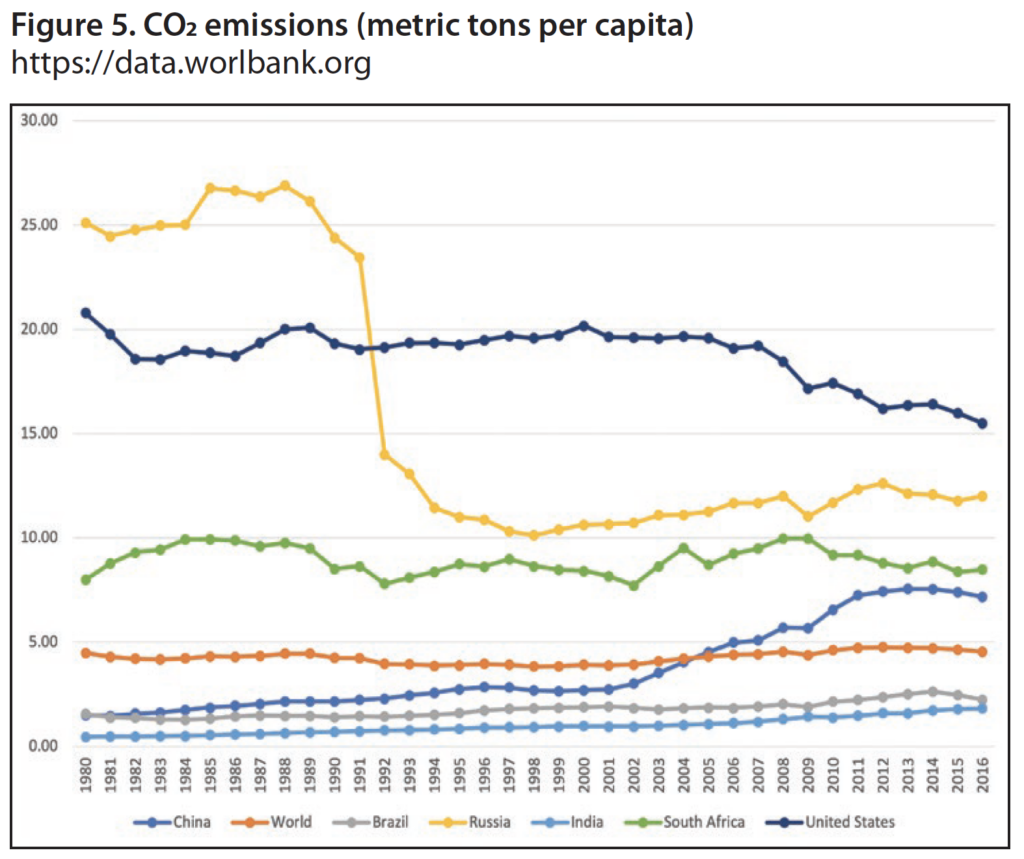
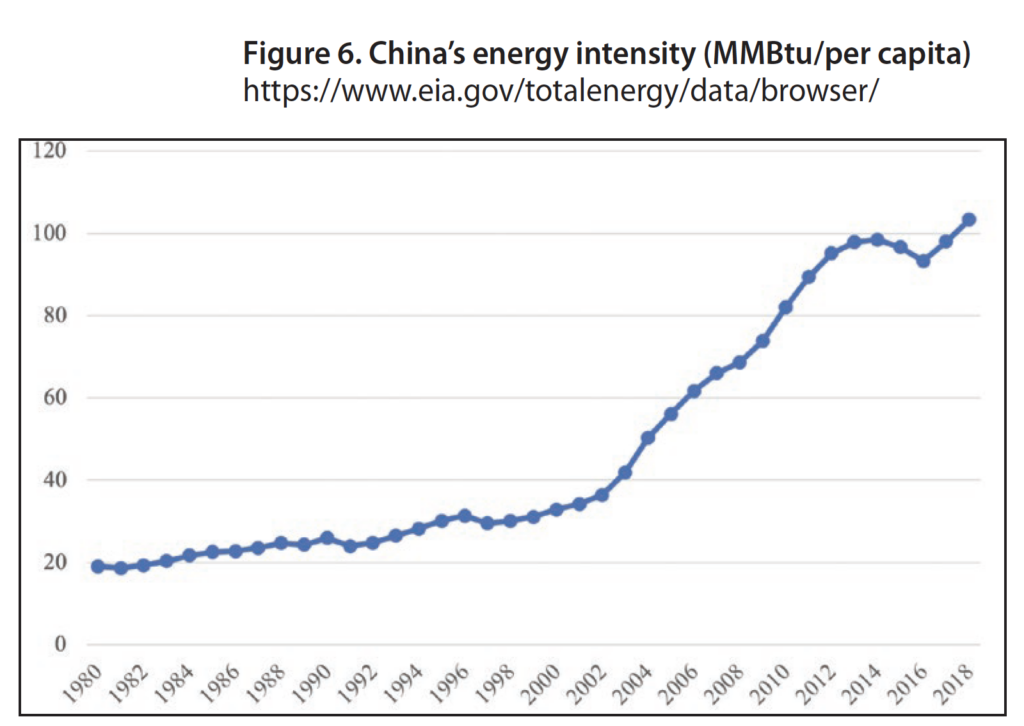
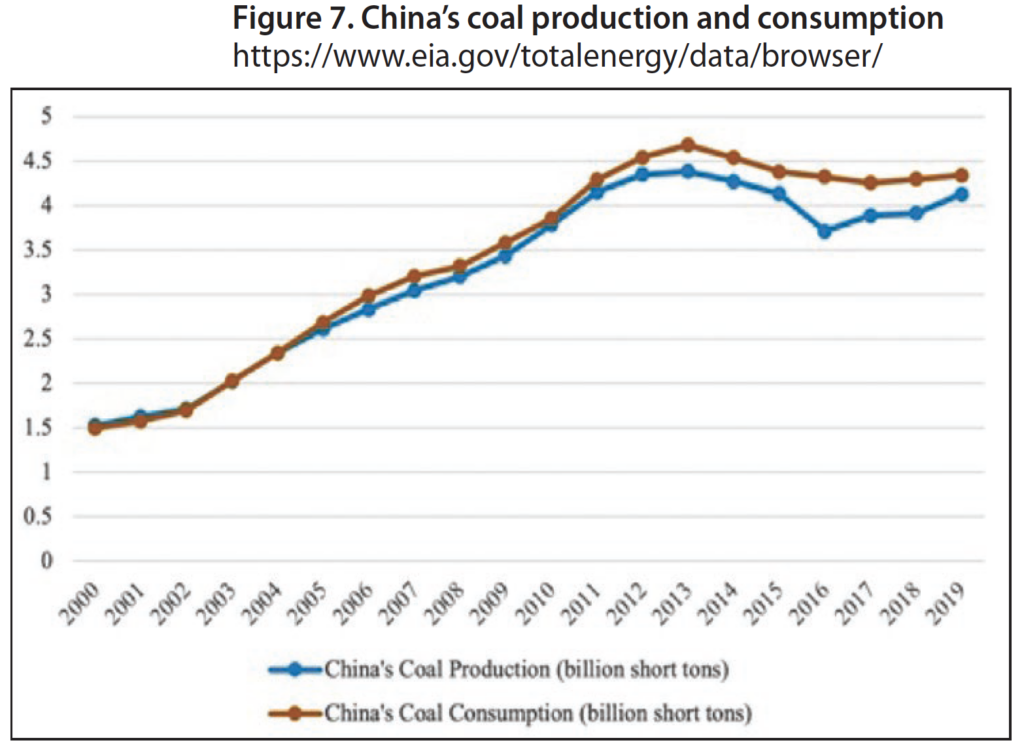
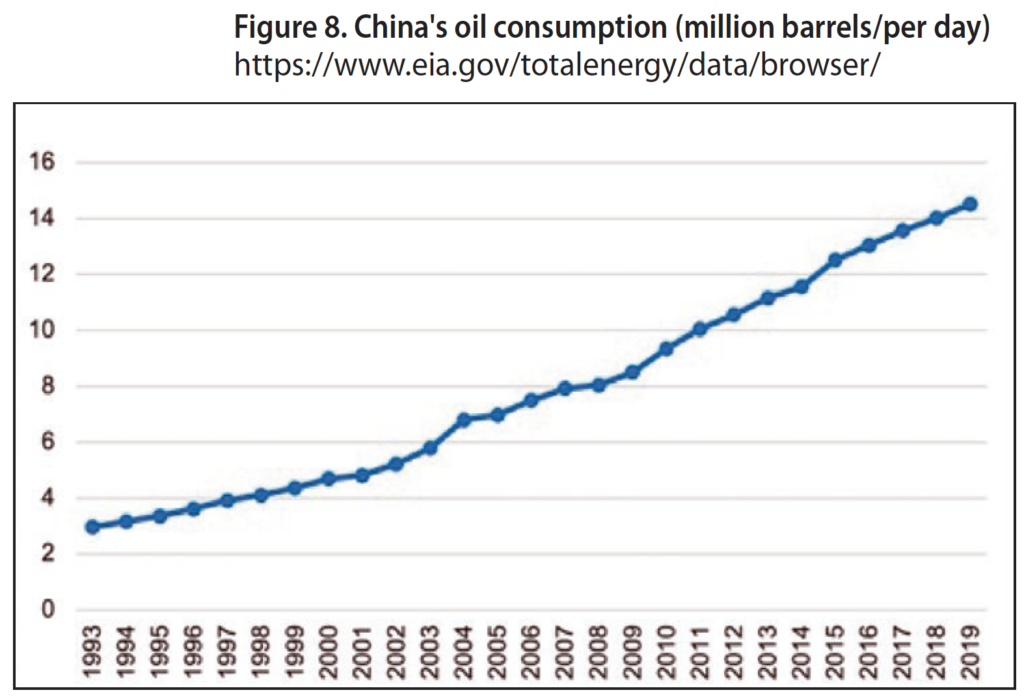
2015 estimates for the BRICS countries and the US suggest that Brazil, India, and South Africa led the share of sustainable energy consumption in overall national energy consumption. Since 2011, China has increased the share of sustainable energy consumption from 11.7% to 12.4% (World Bank, 2021; Figure 10). Importantly, China is going through a clean energy revolution since adopting the 2005 Sustainable Energy Law as well as the 12th and 13th Five-Year Plans covering the period 2011-2020 (Gardner 2018; Guo & Marinova, 2014; Mathews & Tan, 2015; Su & Thom- son, 2016). In as early as 2009, China became the world’s leading investor in sustainable energy technology (Guo & Marinova, 2014). In 2013, China was the top investor in clean energy with a total investment of 61.3 billion (Campbell, 2014). 2015 marked the rise of China to the status of the world’s largest producer of solar, wind, and hydroelectric power (Gardner, 2018). In the 2008-2018 period, furthermore, China’s wind and solar energy consumption rose from 3 and 0 Mtoe to 83 and 40 Mtoe, respectively. Therefore, one could deduce that the share of China’s wind and solar power in national energy consumption rose from 0.1% in 2008 to 3.7% in 2018 (BP, 2019).
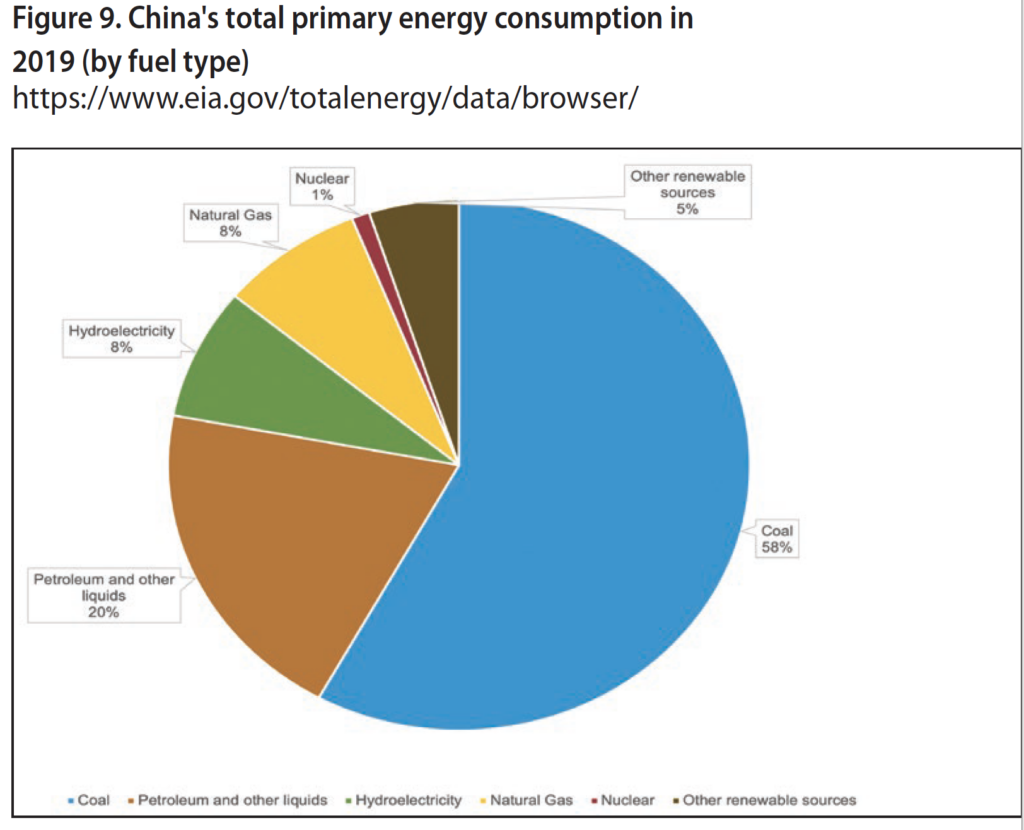
China’s Green Agriculture, Eco-Cities, and Multilateral Environmental Cooperation: An Unfolding Revolution
As mentioned in the introduction, agricultural pollution constitutes a major environmental problem in contemporary China. The country suffers from a scarcity of arable land being the world’s largest pesticide producer and consumer (China-ASEAN Environmental Cooperation 2018:158; Scott et. al. 2018:26). With this in mind, China is currently increasing its focus on green agriculture to fight against agricultural pollution and other environmental strains. China’s agriculture area under organic agriculture rose by over 36% in the 2005-2018 period, from 2,301,300 to 3,135,000 hectares. China’s 2018 performance has even surpassed that of the other BRICS countries and the US in this area (FAO, 2021; Figure 11). That being said, China has a long way to go given that its agriculture area under organic agriculture accounts for only 2.31% of its total agriculture area (FAO, 2021). However, it is worth noting that China possesses the world’s largest agriculture area under organic farming after Australia and Argentina. It is possible to argue that China has also set an example for other countries in the expansion of its certified organic agricultural land use. China’s agriculture area under certified organic agriculture soared from 10 hectares to 2,558,100 hectares from 2004-2018. Due to this, China has become the world’s largest consumer of organic food (FAO 2021; Willer, Lernoud, & Kemper, 2018).
China’s green revolution in agriculture owes much to the efforts of central and local governments at prioritising green agriculture in their overall development strategy (Scott et al., 2018:46). This also accounts for the rise of the eco-village movement in China since the late 1980s. By 1990, China created a total of 1200 “pilot eco-villages” (Liu et al., 2021; Scott et al., 2018:38-39). This number rose to 2000 by the year 2011 (Liu & Wang, 2010:107). The eco-village movement was complemented by strong policy efforts emphasising the widespread adoption of green labelling standards such as green food (lüse shipin), pollution-free food (wugonghai shipin) and organic food (youji shipin) throughout the 1990s. Meanwhile, the Ministry of Agriculture launched a green food programme in 1990 and the China Green Food Development Centre in 1992, which assumed the task of providing the necessary technical support and quality control services to further this process (Scott et al., 2018:39-41).
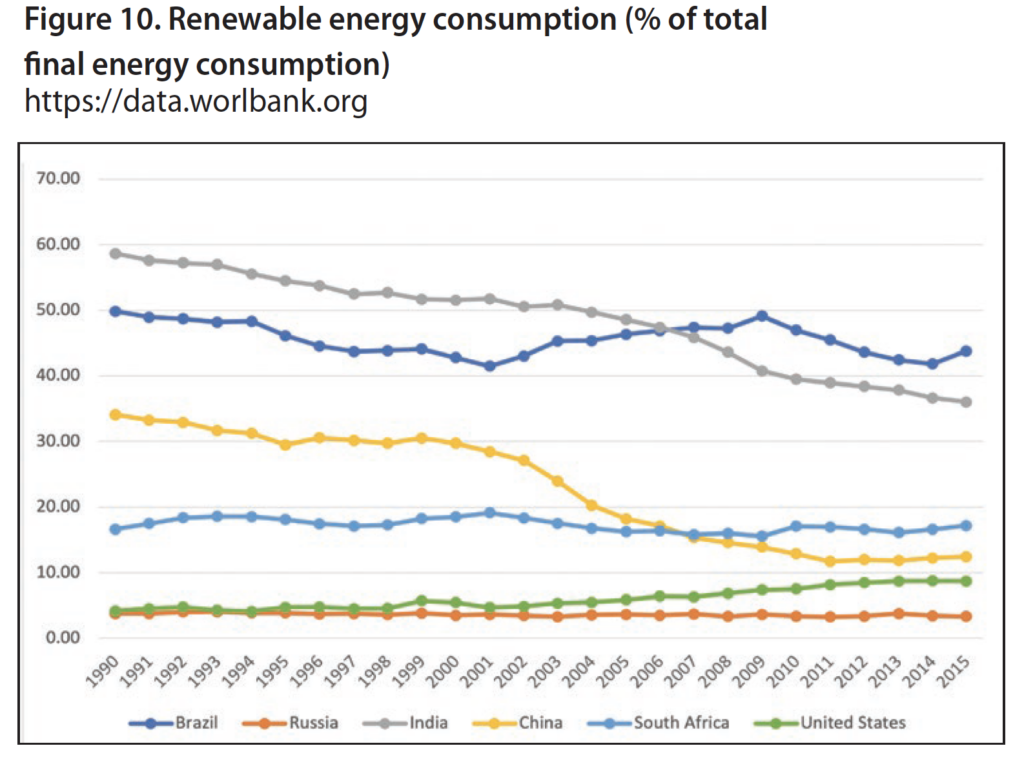
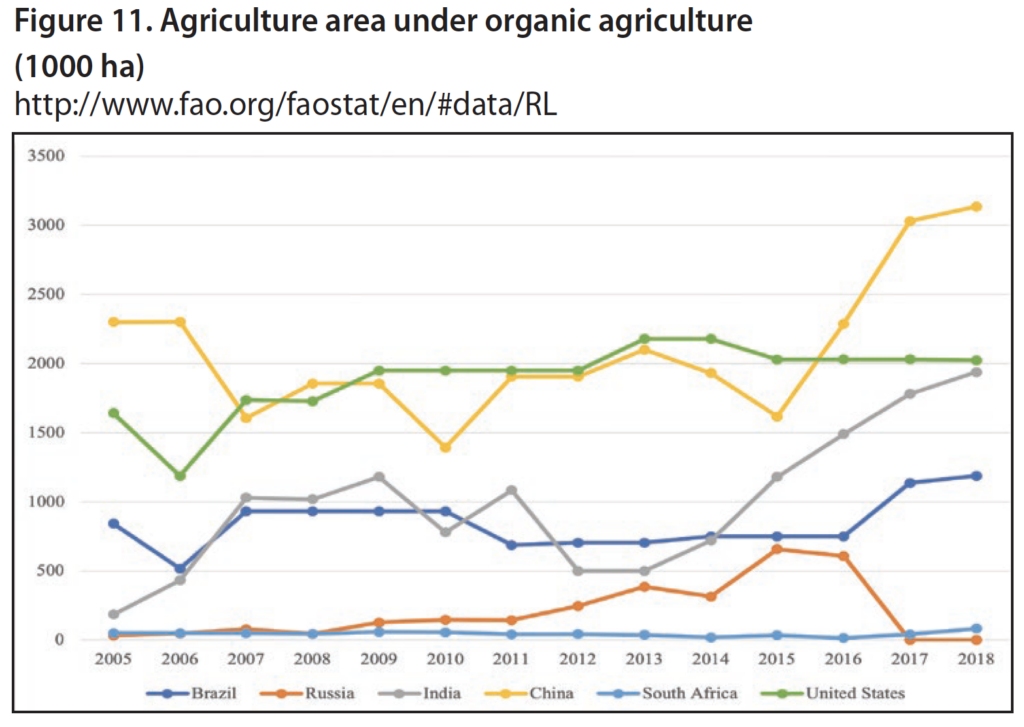
By 2011, China had created 42 certification offices, 38 quality control terminals, and 71 environmental monitoring centres. Moreover, China’s green food programme was complemented by the Risk-Free Food Action Plan in 2001, which sought to fight chemical pollution, improve food security, and accelerate organic certification (Scott et al., 2018:39-41). Ultimately, the National Sustainable Agriculture Development Plan (2015-2030) provided a more systematic and holistic blueprint for China’s efforts in green agriculture. In 2017, No. 1 Central Document, an annual policy document issued by the Central Committee of the CPC and the State Council, elevated green and sustainable development to the status of the second major development goal (Scott et al., 2018:39-41).
China’s efforts in improving green agriculture and building eco-villages go hand in hand with its strategy of sustainable urbanisation (Hu, Liu, & Sun, 2017). The eco-city movement (生态城市) was launched in 2003 on the initiative of the Ministry of Environmental Protection. This initiative sought to create a model of a low-carbon and circular economy, expand green and protected zones, encourage recycling and energy conservation, promote sustainable architecture, prevent air and noise pollution, and improve social welfare and harmony in urban areas (Wang, 2018; Zhou, He, & Williams, 2012). According to research from 2009 conducted by the International Eco-Cities Initiative (IEI), only 6 out of the world’s 79 eco-cities originated from China. In the 2011 IEI survey, the number of China’s eco-cities rose to 25. Research from 2015 conducted by China identified 658 major eco-cities across the world, 284 of which originated from China. This means that more than 43% of the world’s eco-cities are currently based in China (Williams, 2017:4).
The eco-city movement also contributed to China’s efforts in improving multilateral environmental cooperation. Indicative of Chinese leadership in the global eco-city movement are the Tianjin China-Singapore Eco-City, the Sino-Dutch Shenzhen Low-Carbon City, and the Sino-French Wuhan Ecological Demonstration City. Particularly, the construction of eco-industrial parks represents central instances of environmental cooperation among developing countries in the eco-city movement. The China-Singapore Suzhou Industrial Park contains green areas and lakes, whereas the Sino-Singapore Tianjin eco-city possesses systems for energy efficiency, green transportation, green architecture, sewage treatment, and recycling (China-ASEAN Environmental Cooperation, 2018:161; Liu & Lo, 2021:12).
As a locomotive of multilateral environmental cooperation, China has extended its leading role to the Association of Southeast Asian Nations (ASEAN). In 2009, China and ASEAN signed the Strategy on Environmental Cooperation, which later contributed to the creation of the China-ASEAN Environmental Cooperation Centre. This was followed by the China-ASEAN Environmental Cooperation Action Plans for 2011-2013 and 2014-2015 as well as the 2016-2020 Strategy on Environmental Cooperation. These strategies and action plans sought to improve regional efforts in research & development and eco-city construction. Also included in such efforts is the Green Silk Road Envoys Program, which sought to develop staff training, scientific exchange, and political dialogue on matters of sustainability, green innovation and entrepreneurship, biodiversity, and ecological protection (China-ASEAN Environmental Cooperation, 2018:viii).
China has recently accelerated its multilateral environmental cooperation through the channel of the Belt & Road Initiative (BRI). The 2015 “One Belt, One Road” document pledged for the BRI to assume greater responsibility in environmental protection, biodiversity, and climate change. The BRI developed a more systematic approach to sustainability upon Xi Jinping’s 2016 call for the construction of a “green, healthy, intelligent, and peaceful” Silk Road, which led to the publication of the “Guidance on Promoting Green Belt and Road” and the implementation of the Green Action Plan and the Maritime Cooperation Vision driven by the principle of maritime protection (Simonov, 2018). As a result, the Second BRI Forum held in 2019 formulated green investment principles (Cheung & Hong, 2021).
The BRI devotes special attention to ensuring it does not impose policies on its participants and undermine their national sovereignty. The adoption of BRI’s principles on ecological civilization is left to the initiative of participant states (Ikenberry & Lim, 2017). In the Second BRI forum, BRI members were invited to join environmental initiatives such as the International Green Development Coalition, the Sustainable Cities Alliance, the South-South Cooperation Initiative on Climate Change, the Environmental Technology Exchange and Transfer Center, the Environmental Big Data Platform, and the Green Investment Fund (Garey & Ladislaw, 2019; Iken- berry & Lim, 2017). These initiatives gained momentum in response to rising criticism on the part of civil society groups against the majority of BRI investments being transferred to carbon-driven sectors and large-scale infrastructure development at the expense of local environments (Harlan, 2021).
Coupled with BRI’s forum initiatives is green finance, which includes financial practices involving bonds that fund sustainable projects, credits that support sustainable investments, and insurance schemes for protection against environmental disasters. Chinese green investment has supported environmental initiatives such as low-carbon transportation, high-speed trains, clean energy projects, projects against environmental pollution, and clean coal investments. As such, China has risen to the status of the world’s top leader in green bonds and credits by outperforming the US in 2019 (Green Belt and Road Initiative Center, 2019b, Chinadaily 2020b; Harlan 2021; Rooney 2019).
The Asian Infrastructure Investment Bank (AIIB) –as Asia’s first bank to be independent from Western hegemony and the world’s fourth-largest multilateral development bank– constitutes an important financial vehicle for BRI (Gürcan, 2020; Fahamu, n.d.; Koop, 2018). It started to operate in 2016 under China’s initiative as “the world’s first multilateral development bank (MDB) dedicated to infrastructure” (Wilson, 2017). The declared intention of the bank is to fill the “gap between supply and demand for infrastructure spending in Asia”, which was estimated at “as high as $8 trillion by 2020” (Cai, 2018). The bank’s approved projects mostly focus on the energy, water, and transportation sectors (Chen, 2019). Almost half of these projects are co-financed with other financial institutions such as the Asian Development Bank, the European Bank for Reconstruction and Development, the Islamic Development Bank, and the World Bank (Rana, 2019; Bustillo & Andoni, 2018). In the period 2016–2017, the AIIB approved nearly $5 billion in loans, and 35 infrastructure projects with an estimated value of $28.3 billion (Cai, 2018; Chen, 2019). Unlike the World Bank, the AIIB does not impose political conditionality and does respect the sovereignty of claimant nations (Gürcan, 2020).
China’s initiative has led the AIIB to adopt a strong stand on ecological civilization. In 2016, the AIIB adopted the Environmental and Social Framework (ESF), which encourages financed development projects to target social and environmental sustainability in tandem, including green economy, gender equality, and labor rights. As regards environmental sustainability, the ESF places a strong emphasis on balanced development, decreasing fossil fuel consumption, environmental resilience, energy conservation, and biodiversity (Gabusi, 2019). In its second annual meeting held in South Korea in 2016, the AIIB adopted the Sustainable Energy for Asia Strategy and approved its first loan for a project that seeks to reduce coal use in China. The AIIB’s fourth meeting was held in Luxembourg in 2019, where the bank reiterated its commitment to supporting green economy (Altay & Zeynepcan, 2020). The AIIB’s new funds that target social and environmental sustainability include “the $75 million Tata Cleantech Sustainable Infrastructure On-Lending Facility (India), US$75 million Asia Investment Fund (Asia-wide), US$100 million L&T Green Infrastructure On-Lending Facility to finance wind and solar energy projects (India), US$200 million TSKB Sustainable Energy and Infrastructure On-Lending Facility (Turkey), and US$150 million to the India Infrastructure Fund to finance infrastructure projects including renewable energy (India)… [as well as] a US$500 million AIIB Asia ESG Enhanced Credit Managed Portfolio (Asia-wide) with Aberdeen Standard Investments, to partner on developing debt capital markets for infrastructure… [and the] US$ 500 million fund, the Asia Climate Bond Portfolio, to accelerate climate action in the Bank’s members, and spur the development of the climate bond market.” (Vazquez & Chin, 2019: 598) Besides energy and infrastructure, the AIIB’s green framework extends to sustainable urbanization, green transportation, and rural sustainability. These efforts are clearly exemplified in a US$329 million loan for India’s Gujarat Rural Roads Project, a US$335 million loan for India’s Metro Line Project, a US$140 million loan for India’s Madhya Pradesh Rural Connectivity Project, a US$445 million loan for India’s Andhra Pradesh Rural Roads Project, a US$40 million loan for Laos’ National Road 13 Improvement and Maintenance Project, a US$216.5 million loan for Indonesia’s National Slum Upgrading Project, a US$270.6 million loan for the Philippines’ Metro Manila Flood Management Project, a US$400 million loan for India’s Andhra Pradesh Urban Water Supply and Septage Management Improvement Project, a US$200 million loan for Sri Lanka’s Colombo Urban Regeneration Project, and a US$100 million loan for Bangladesh’s Municipal Water Supply and Sanitation Project (Vazquez & Chin, 2019).
Finally, a word of caution: it is too early to estimate the future of the AIIB and BRI’s contributions to ecological civilization, given that the Green Silk Road project was only put into action in 2019, whilst the AIIB started to operate in 2016. However, there is room for optimism considering that China has already become a leading country in multilateral environmental cooperation. The AIIB’s strategy on social and environmental sustainability has already been put into practice through green funds implemented in several Asian countries. Furthermore, China’s green investments as part of the BRI have gained momentum since 2016. Cases include China’s increasing investments in Vietnam’s solar panels, its leading role in establishing the Quaid e-Azam Solar Park and the Jhimpir Wind Farm in Pakistan, the Aisha Wind Farm and Wolayita Sodo Power Transmission Line in Ethiopia, and other similar projects in countries such as Thailand and Malaysia (Chernysheva et al., 2019).
Review and Discussion
As a strong expression of ecological imperialism, prompted by neoliberal globalisation and the Third Industrial Revolution, Western metropoles initiated the shift in axis for global production to Asia. This enabled Western metropoles to take advantage of cheap labour supplies and access natural resources in the absence of strict environmental regulations (Gürcan, Kahraman & Yanmaz, 2021). China was the main target of these pillaging efforts. However, it managed to benefit from these neoliberal assaults by utilising public-driven policies, which, despite a number of liberal compromises, served to protect itself from becoming a neo-colony. Public-driven policies also served to build a strong economy driven by national interests, thus generating grave concerns for Western metropoles whose global hegemony was challenged. As a result, Western metropoles now resort to an ecological-imperialist campaign that blames environmental degradation on developing countries, particularly China, whose leading environmental efforts –as the locomotive of global welfare and the greatest enemy of global poverty– are often undermined by this Western-centric campaign.
China has developed a firm awareness of its environmental problems, which are realised in its revised national security strategy that incorporates the concept of “ecological civilization”. China is in the early stages of building an ecological civilization and still has a long way to go before it reaches a high level of ecological development. Perhaps the most immediate threat to ecological civilization stems from the growing aggression of US imperialism in the form of geopolitical containment strategies, techno-economic wars against China, and other factors related to the COVID-19 pandemic such as Western-fueled Sinophobia and pandemic-related economic strains (Gürcan, 2019; Gürcan, Kahraman & Yanmaz, 2021). Nevertheless, China’s key achievements on the path towards ecological civilization involve a series of three unfolding and mutually conditioning revolutionary processes that also lead the way in international environmental cooperation, as embodied in China’s role in ASEAN, the AIIB, and the Green Silk Road. They include a clean energy revolution, a sustainable agricultural revolution, and a green urban revolution.
China has already become a global leader in green finance. It leads the eco-city movement with over 43% of the world’s eco-cities being Chinese and is the second leader in sustainable architecture, next to Canada. Many Chinese cities have dropped down or out of the list of the most polluted cities, leaving India and Pakistan at the top. China’s cities have also joined the ranks of those with the strongest sewage treatment capacity in the world. Another point worth mentioning is that China has the most electric vehicles, bikes, and efficient public transportation. China is considered, not only as the world’s centre of electric bus production and consumption but also as having cities with the world’s longest subway systems. From 2013 onwards, the share of coal in China’s total energy consumption has seen a noticeable decline, accompanied by the increasing share of renewable resources in total energy consumption as a result of conscious efforts at a clean energy revolution. Key to this revolution in the making is China’s strong reputation as the world’s top investor in clean energy. As such, it has succeeded in creating the world’s largest wind, solar, and hydroelectric systems for power generation. Finally, concerning China’s unfolding revolution in sustainable agriculture, one should acknowledge its adoption of green food standards, the expansion of its agricultural area under certified organic farming, and especially the fact that, as a world leader in green agriculture, it now has the third-largest agricultural area under organic farming. Ultimately, the continuation and amplification of all these achievements are predicated on the future determination of the Xi Jinping administration (and its successors) to build ecological civilization while facing imperialist aggression.
References
Altay, A., & Zeycepcan A. (2020). China’s Relationship with the Liberal International Order: The Case of the Asian Infrastructure Investment Ban. Marmara University Journal of Political Science. doi: 10.14782/marmarasbd.784428
BP. (2019). China’s Energy Market in 2018. BP Statistical Review.
Bustillo, R., Andoni, M. (2018). China, the EU and Multilateralism: The Asian Infrastructure Investment Bank. Revista Brasileira de Politica Internacional, 61(1): 1–19.
Cai, K G. (2018). The One Belt One Road and the Asian Infrastructure Investment Bank: Beijing’s New Strategy of Geoeconomics and Geopolitics. Journal of Contemporary China, 27(114): 831–847.
Campbell, R. J. (2014). China and the United States: A Comparison of Green Energy Programs and Policies. R41748. Congressional Research Service.
Chen, I. T. (2019). China’s Status Deficit and the Debut of the Asian Infrastructure Investment Bank. The Pacific Review, 1–31: 697–727.
China Daily. (2017). Full Text of Xi Jinping’s Report at 19th CPC National Congress. Retrieved from https://www.chinadaily. com.cn/china/19thcpcnationalcongress/2017-11/04/con- tent_34115212.htm
China Daily. (2020). Green Finance in China: Enabling a Sustainable Recovery. Retrieved from https://www.chinadaily. com.cn/a/202009/18/WS5f647ad8a31024ad0ba7a79c.html
Chernysheva, N. A., Perskaya, V. V., Petrov, A. M., & Bakulina, A. A. (2019). Green Energy for Belt and Road Initiative: Economic Aspects Today and in the Future. International Journal of Energy Economics and Policy 9(5):178-85.
Cheung, F. M., & Hong, Y. (Eds.). (2021). Green Finance, Sustainable Development and the Belt and Road Initiative. London: Routledge.
China-ASEAN Environmental Cooperation. (2018). China-ASEAN Environment Outlook 1 (CAEO-1): Towards Green Development. Singapore: Springer.
Corff, O. (2018). Rich Country, Strong Army”: China’s Comprehensive National Security. Federal Academy for Security Policy.
Earth.Org. (2021). 15 Most Polluted Cities in the World. Retrieved from https://earth.org/most-polluted-cities-in-the-world/
EIA. (2021). Database. Retrieved from https://www.eia.gov/totalenergy/data/browser/.
Environmental Performance Index. (2020a). Global Metrics for the Environment: Ranking Country Performance on Sustainability Issues. Retrieved from https://www.unep.org/resources/ report/global-metrics-environment-environmental-performance-index-ranks-countries).
Environmental Performance Index. (2020b). China | Environmental Performance Index. Retrieved from https://epi.yale.edu/epi-results/2020/country/chn
Fahamu. (n.d.). 57 nations approved as founder members of China-led AIIB. Retrieved from http://www.fahamu.org/ep_articles/57-nations-approved-as-founder-members-of-china-led-aiib/#:~:text=Countries%20accepted%20as%20AIIB%20founding,%2C%20France%2C%20Germany%20and%20Spain
FAO. (2021). Database. Retrieved from http://fao.org/faostat/en/#data/RL
Gabusi, G. (2019). Global Standards in the Asian Infrastructure Investment Bank: The Contribution of the European Members.
Gardner, D. K. (2018). Environmental Pollution in China: What Everyone Needs to Know. New York: Oxford University Press.
Garey, L., & Ladislaw, S. (20199. Chinese Multilateralism and the Promise of a Green Belt and Road. CSIS Briefs. Center for Strategic & International Studies.
Goron, C. (2018). Ecological Civilization and the Political Limits of a Chinese Concept of Sustainability. China Perspectives, (4):39-52. doi: 10.4000/chinaperspectives.8463.
Green Belt and Road Initiative Center. (2019). Green Finance. Retrieved from https://green-bri.org/green-finance/
Greene, H. (n.d.). Ecological Civilization and the 19th National Congress of the Communist Party of China. Center for Ecozoic Studies. Retrieved from https://www.ecozoicstudies.org/re- views/ecological-civilization-19th-national-congress-communist-party-china/
Guo, X., & Marinova, D. (2014). Environmental Protection and Sustainability Strategies in China: Towards a Green Economy. In S. Yao & M. J. Herrerias, (ed.) Energy Security and Sustainable Economic Growth in China, pp. 286-301. New York: Palgrave Macmillan.
Gürcan, E. C. (2019). Multipolarization, south-south cooperation and the rise of post-hegemonic governance. New York: Routledge.
Gürcan, E. C. (2020). The construction of “post-hegemonic multipolarity” in Eurasia: A comparative perspective, The Japanese Political Economy, 46(2-3), 127-151. doi: 10.1080/2329194X.2020.1839911
Gürcan, E. C., Kahraman, Ö. E. & Yanmaz, S. (2021). COVID-19 and the Future of Capitalism: Postcapitalist Horizons Beyond Neo-Liberalism. Nova Scotia: Fernwood Publishing.
Harlan, T. (2021). Green Development or Greenwashing? A Political Ecology Perspective on China’s Green Belt and Road. Eurasian Geography and Economics 62(2):202-26. doi: 10.1080/15387216.2020.1795700.
Hu, J. (2007). Hu Jintao’s report at 17th Party Congress. China Daily. Retrieved from https://www.chinadaily.com.cn/china/2007-10/24/content_6204564.htm
Hu, W., Liu, J. & Sun, W. (ed.). (2017). The Development of Eco Cities in China. Singapore: Springer.
Hu, X. (2020). Forecast of China’s Average Annual Economic Growth Rate Based on BP Neural Network. J. Phys.: Conf. Ser. 1629 012040.
Ikenberry, G. J., & Lim, D. J. (2017). China’s Emerging Institutional Statecraft: The Asian Infrastructure Investment Bank and the Prospects for Counter-Hegemony. Brookings.
INSG. (2014). The Global E-bike Market. Briefing Paper. 23. IQAir. (2021). World’s Most Polluted Cities in 2020 – PM2.5 Ranking | AirVisual. Retrieved from https://www.iqair.com/world-most-polluted-cities
Jie, S. (2016). Groundwater 80% Polluted. Global Times. Retrieved from https://www.globaltimes.cn/content/978117.shtml
Kitagawa, H. (ed.). (2016a). Environmental Policy and Governance in China. New York: Springer.
Kitagawa, H. (2016b). Environmental Policy Under President Xi Jinping Leadership: The Changing Environmental Norms. In H. Kitagawa, (ed.), Environmental policy and governance in China, pp. 1-15. New York: Springer.
Koop, F. (2018). Explainer: Latin America and the AIIB. Diálogo Chino. Retrieved from https://dialogochino.net/en/trade-in- vestment/39049-explainer-latin-america-aiib-the-asian-infrastructure-investment-bank/
Liu, C., Wang, F., Gao, X. & Smith, H. (2021). Exploring Solutions to Improve the Evaluation of Development of Rural Villages: A Case Study of the Application of the Evaluation for the Construction of Beautiful Villages (ECBV) in a Village in South China. Sustainability 13(2):1-23.
Liu, J., & Wang, J. (2010). China’s Environment. Beijing: China International Press.
Liu, M., & Lo, K. (2021). Governing Eco-Cities in China: Urban Climate Experimentation, International Cooperation, and Multilevel Governance. Geoforum, (121), 12-22. doi: 10.1016/j. geoforum.2021.02.017.
Long, M. (2015). USGBC Announces International Rankings of Top 10 Countries for LEED Green Building | U.S. Green Building Council. USGBC. Retrieved from https://www.usgbc.org/ articles/usgbc-announces-international-rankings-top-10-coun- tries-leed-green-building
Ma, H., et al. (2018). Strategic Plan of Made in China 2025 and Its Implementations. Analysing the Impacts of Industry 4.0 in Modern Business Environments, pp. 1-23. Singapore: IGI Global.
Mao, Z. (1974). Mao Tse-Tung Unrehearsed: Talks and Letters, 1956-71. S. R. Schram, (Ed.). Harmondsworth: Penguin.
Markets and Markets. (2021). Electric Bus Market by Propulsion (BEV, PHEV & FCEV), Application (Intercity & Intra-City), Consumer Segment (Fleet Operators & Government), Range, Length of Bus, Power Output, Battery Capacity, Component, Battery Type & Region – Global Forecast to 2027. Retrieved from https://secure.livechatinc.com/
Mathews, J. A., & Tan, H. (2015). China’s Renewable Energy Revolution. New York: Palgrave Macmillan.
Morton, K. (2006). International Aid and China’s Environment: Taming the Yellow Dragon. London: Routledge.
Naughton, B.J. (2018). The Chinese Economy: Adaptation and Growth (second edition). Cambridge: MIT Press.
Nedopil Wang, C. (2019). Green Public Transport Innovation in China: An Opportunity for BRI Countries. Green Belt and Road Initiative Center. Retrieved from https://green-bri.org/ green-public-transport-innovation-in-china-an-opportunity-for-bri-countries/
Pan, J. (2016). China’s Environmental Governing and Ecological Civilization. Heidelberg: Springer.
Raik, K., Aaltola, M., Kallio, J., & Pynnöniemi, K. (2018). The Security Strategies of the US, China, Russia and the EU: Living in Different Worlds. Helsinki: Finnish Institute of International Affairs.
Rana, R. (2019), Asian Infrastructure Investment Bank, New Development Bank and the
Reshaping of Global Economic Order: Unfolding Trends and Perceptions in Sino-Indian
Economic Relations, International Journal of China Studies, 10 (2):273–290.
Robbins, P. (ed.). (2007). Encyclopedia of Environment and Society. London: SAGE.
Rooney, K. (2019). These Countries Are Leading the Way in Green Finance. World Economic Forum. Retrieved from https://www. weforum.org/agenda/2019/09/these-countries-are-leading-the-way-in-green-finance/
Sanjuan, T. (2018). Atlas de la Chine: Les Nouvelles Échelles de la Puissance. Paris: Autrement.
Scott, S., Si, Z., Schumilas, T., & Chen, A. (2018). Organic Food and Farming in China: Top-down and Bottom-up Ecological Initiatives. New York: Routledge.
Simonov, E. A. (2018). Greening The New Silk Road: Mission Possible? 3. Rivers Without Boundaries. doi: 10.13140/ RG.2.2.23726.20806.
Su, B., & Thomson, E. (Eds.). (2016). China’s Energy Efficiency and Conservation: Sectoral Analysis. Singapore: Springer.
Sustainable Bus. (2020). Electric Bus, Main Fleets and Projects Around the World. Retrieved from https://www.sustain-able-bus.com/electric-bus/electric-bus-public-transport-main- fleets-projects-around-world/
Statista. (2021). Production of Electric Vehicles: Selected Countries. Retrieved from https://www.statista.com/statistics/270537/forecast-for-electric-car-production-in-selected-countries/
Technavio. (2019). Electric Buses in China: Largest Electric Bus Market 2019 | Global Electric Bus Market Report. Retrieved from https://blog.technavio.com/blog/electric-buses-in-china- largest-electric-bus-market
U.S. Department of Defense. (2020). Annual Report to Congress: Military and Security Developments Involving the People’s Republic of China 2020. Retrieved from https://media. defense.gov/2020/Sep/01/2002488689/-1/-1/1/2020-DOD- CHINA-MILITARY-POWER-REPORT-FINAL.PDF
Wang, X. (2018). Tomorrow’s Eco-City in China: Improving Eco-City Development Though a Culture of Collaborative Communication. Unpublished Ph.D. Thesis. University of Liverpool, School of Environmental Science Department of Geography and Planning.
Willer, H., Lernoud, J. & Kemper, L. (2018). The World of Organic Agriculture 2018: Summary. FiBL & IFOAM. Retrieved from https://orgprints.org/id/eprint/34674/1/willer-etal-2018-world- of-organic-summary.pdf.
Williams, A. (2017). China’s Urban Revolution: Understanding Chinese Eco-Cities. New York: Bloomsbury Publishing.
Wilson, J. D. (2017). What Does China Want from the Asian Infrastructure Investment
Bank? Indo-Pacific Insight Series, Perth US Asia Centre.
World Bank. (2021). Database. Retrieved from https://data.worldbank.org
Xi, J. (2018). The Governance of China (I). C. 1. Pekin: Beijing Book Co. Inc.
Vazquez, K. C., & Chin, G. T. (2019). The AIIB and Sustainable Infrastructure: A Hybrid Layered Approach. Global Policy, 10(4), 593-603.
Yang, J. (2018). Construction of “Beautiful Village” Landscapes from the Perspective of Ecological Civilization: A Case Study of Zizhulin Village in Yanshan County. Journal of Landscape Research, 10(4),120-22. doi: 10.16785/j.issn1943-989x.2018.4.027.
Zhang, J. (2014). Foreign Direct Investment: Regional Dimensions. New York: Palgrave Macmillan.
Zhou, N., He, G., & Williams, C. (2012). China’s Development of Low-Carbon Eco-Cities and Associated Indicator Systems. LBNL-5873E, 1172952. U.S. Department of Energy: Office of Scientific and Technical Information.
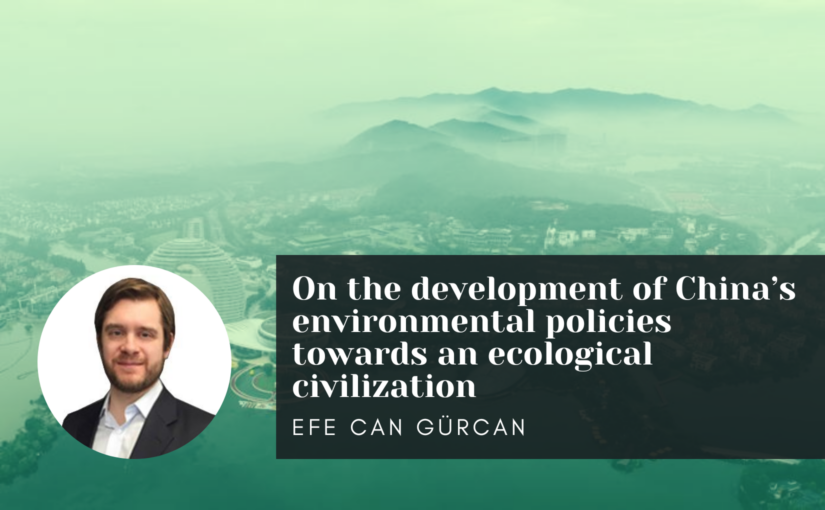

3 thoughts on “On the development of China’s environmental policies towards an ecological civilization”